Mali
Things to Do
Dogon Country
History
The Dogon where not the original inhabitants of the Bandiagara escarpment. Their predecessors
were known as Tellem, myserious people who built houses on the rocks of the cliff face,
buried their dead in caves high above these houses, and made some of the earliest cloth and
wooden objects found in sub-Sahara Africa.
The Dogon reached the Badiagara escarpment around the 14th or 15th century. Most agree that
four families - The Dyon, Arou, Ono and Domno - were the first to arrive at
Kani Bonzon led there, apparently, by a dog. These families exist to this day and decendants of the forefathers
are dispersed in different villages throughout Dogon country.
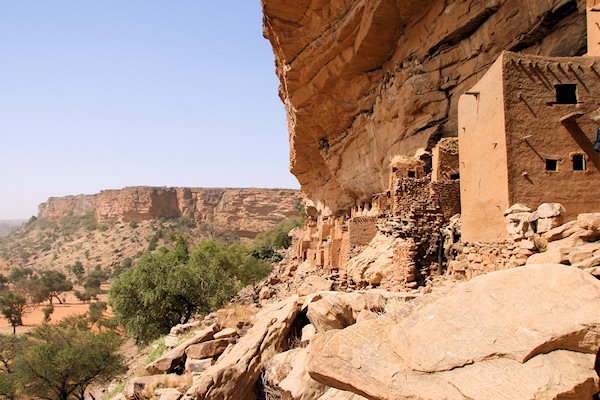 |
|||||
The Tellem were probably hunters; the Dogon, on the other hand, were cultivators. When the latter
arrived in Tellem country they may have cleared the forest, which at that time covered the plain,
so that they could farm the land. The Tellem, thus deprived of their traditional means of survival,
deserted the cliffs never to be seen again.
After the depature of the Tellem, the Dogon's main enemy were the fiercely Islamic Peul,
who frequently attacked them on horseback from the Peul heartland on the plain. The former managed
to keep control of the falaise (escarpment) and the plateau, but only started to spread out
on the plain after the French had conquered the region and pacified the people - both Peul and
Dogon - in 1921.
By 1937 almost half of the Dogon had left the cliffs to live on the plain where water was more
plentiful and land easier to cultivate.
The Dogon survive by farming small plots of land on the plateau, plain and wherever else water can
be found. Some of what is produced is for personal consumption, while the rest is sold at the market.
The main crops are millet, rice, sorghum and onions, which are a common sight - and smell - in
Dogon country. When the onions ripen they are pounded into pasta, which is then rolled into balls
and dried in the sun. Formerly used as currency, these onion balls are still traded as far away as
Bamako and Côte d'Ivoire.
The Dogon raise animals - cattle, goats, sheep, chickens, donkeys etc - for food, sacrifice or work;
and small-scale hunting with flintlock rifles made by their own blacksmiths also take place.
The other mainstay of the Dogon economy is the revenue derived from tourism; the sale of arts and
crafts, village taxes, guides, accomondation etc.
Trekking in Dogon Country
Although most people come to visit the cliff villages built on the rocks of the Bandiagara escarpment, otherwise know as the falaise, which cuts a 200km swath through central Mali, Dogon country actually covers an area of some 4.000Km2, with hundreds of settlements on the plateau and the vast Gondo Plain, which streches south from the cliffs into Burkina Faso.
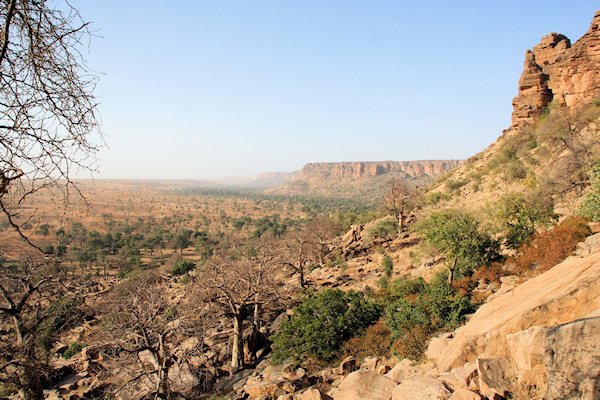 |
|||||
The land of
the Dogon is divided into four cercles: Bandiagara and Douentza on the plateau, Bankass and
Koro on the plain. These, in turn, are split into several arrondissements.
Along the escarpment, the most popular tourist route is between the villages of Banani in the
northeast and Kani Kombolé in the southwest. Here you will find the picture-postcard Tellem
architecture, the acient burial caves, villages built precariously on the rocks of the cliff face and
other quintessentially Dogon attractions. The distance between Banani and Kani Kombolé is about 45km
and, of course, it is quite feasible to trek from one to the other, eating and sleeping at village
campements en route. It can be done within five days.
All villages between Kani Kombolé and Banani now have at least one campement. These should not
be compared to others across Mali, for in Dogon country creature comforts are miniml. You must wash
with buckets of water, taking great care not to use too much of this precious commodity, and sleep on
lumpy mattresses in box-like rooms or on the roof.The majority of
Dogon village
The layout of a Dogon village is rarely haphazard. Even though the style of the village can
vary depending on whether you are along the falaise, on the plateau or on the plain,
urban planning is always indelibly linked to Dogon spititual beliefs and symbolism.
Villages are usually divided into several, often quite autonomous quaters, each made up of a
grouping of family households or ginna. The layout of each ginna, which comprises
the house of the head of the family, the ginna bana, as well as other habitations for
his wives and children, store rooms and stables, is considered to represent a man lying on his
side in the act of procreation, while the habitations themselves often symbolise a human body.
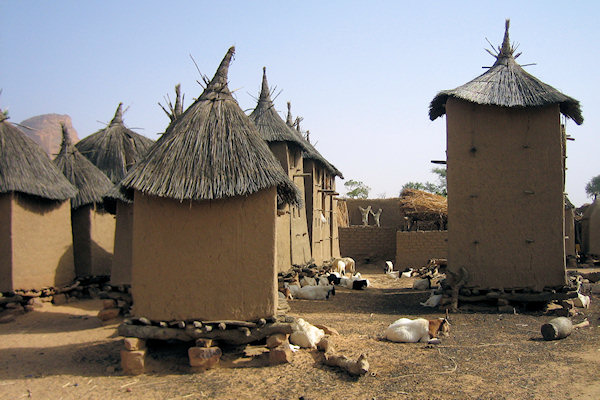 |
|||||
The granaries are one of the most distinctive features of a Dogon village. These mud
pillboxes with thatched roofs like witches'hats are used to store millet and other wordly
possessions: clothes, pottery, jewellery, food for the family etc, depending on whether a
granary belongs to a woman or a man.
In the centre of each village, or quater, there is a togu na, a shelter reserved for men,
where the elders hold meetings, councils and pronounce judgements. eight posts - symbolising
the original ancestors - support a thick, millet-stalk roof which is only 1,2m off the ground.
This provides maximum shade - for this is also a place of rest and relaxation - and prevents
standing up whilst in the togu na.
The only circular buildings to be found in Dogon country are the maison des femmes or
menstruation houses. Woman are considered to be impure during their period and are banished
to these hovels, many of which are decorated with mud carvings of men and women with huge
genitals and real pubic hair, until they have finished menstruating.
The binou shrine is a decorated, single-chambered building. as a spiritual leader of
the binou clan, the binou priest is responsible for maintaining a harmonius relationship between
the clan-members and the supernatural world.
The house of the hogon is associated with the lebe cult. The hogon and the binou priest
may be considered as complementary counterparts, as they both serve as spiritual leaders. When
a hogon dies he is succeeded through election by one of the village elders. After a period of
initation the new hogon has to live by strict rules and taboos. One of these forbids him from
leaving his compound and he is not to be touched by anyone - not even his wife and family.
Bogolan
In recent years the stark black and white designs of Bogolan, which translates as
"mud cloth" have become, one of the best known African cloth traditions around the world.
The production of Bogolan cloth involves a unique and lengthy procedure.
The raw material is provided by plain white cotton cloth woven by men in narrow strips on the
local version of the double heddle loom. The plain cloth that is to be turned into bogolan is
first sewn up into a woman's wrapper cloth or whatever other garment the customer requires.
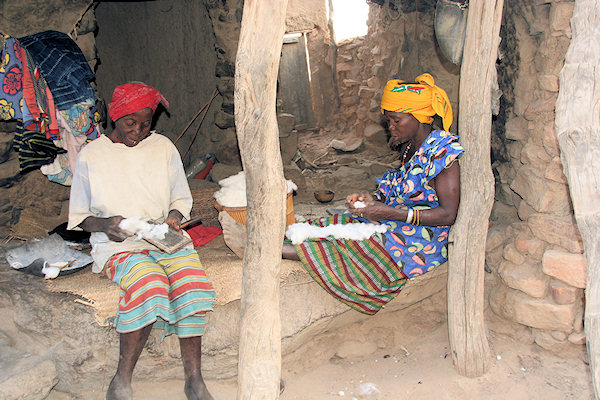 |
|||||
The cloth is first washed in water and allowed to dry so that it can shrink to its final size.
It is then soaked in a brown solution made from the pounded leaves of certain trees. Although
the main leaves used are widely known, specialists have their own precise closely guarded recipes
to give the best results. Once the cloth has been soaked in the mixture it takes on a deep even
yellow colour which fades only slightly when it is spread out on the ground to dry in the sun.
It is now ready for the mud dye to be applied.
The mud used is collected from ponds and left to ferment in a covered pot for about a year, during
which time it becomes black.
Small pieces of bamboo and flat metal spatula of various widths are used to draw the design onto
the cloth using the mud solution. When all the designs have been drawn in outline she then uses
a wider implement to fill in the mud dye over the spaces left between them. One of the unique
features of high quality bogolan is that it is the background not the designs themselves that
are painted onto the cloth leaving the design in the remaining undyed areas.
The cloth is then washed with water to remove any excess mud leaving a black background from which
the yellow designs stand out. The whole process of dipping the cloth in the leaf solution and
outlining the designs with a layer of black mud dye is then repeated, giving the cloth a second
coating of dye.
The final stage is to apply a solution that includes caustic soda to the yellow areas so that
they are bleached to the desired white. It would seem strange to begin with a white cloth, dye it
to yellow, then finish up by treating the yellow areas so they become white again.
The reason for this apparently paradoxical procedure lies in the chemical processes at work in
the dyeing process. The active ingredient in the mud dye is iron oxide, which is converted by
tannic acid in the leaf solution into a fast dye of iron tannate. The yellow stage is therefore
essential although as a colour it is not present on the finished cloth.
You can observe the different laborius stages of production, from spinning and weaving of cotton,
to the proces of decorating the blankets, in the Dogon villages.
Musee de Nombori
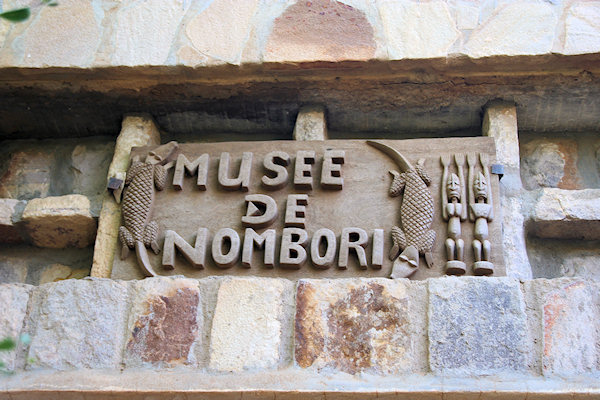 |
|||||
On arriving in Nombori, it is hard to miss the museum. Inaugurated in december 2002,
this was the first museum to be created as part of a programme by the Mission Culturelle
to promote sustainable tourism in Dogon country. Its purpose is not only to cater for passing
tourists, but also to encourage the local people to conserve, protect and promote their culture
heritage. The locals were heavily involved in the development of the idea and the construction
of the museum, and now they enjoy the benifit of the income generate by the museum.
It should be open during the daytime, but if it isn't ask any villager to find the museum warden.
The exhibition shows numerous artefacts that have been handed in by the people of Nombori,
along with some interesting explanations - currently in french only.
Dance des Masques
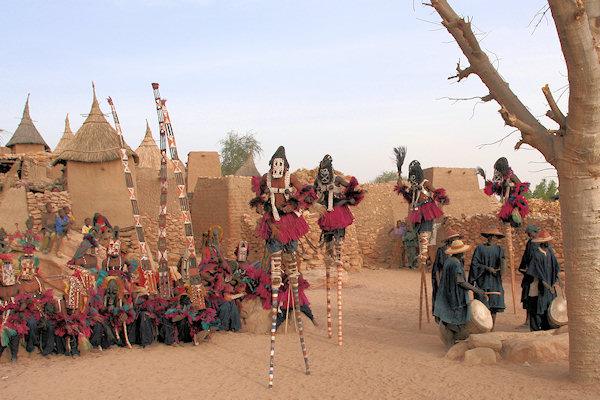 |
|||||
Dogon rituals are, naturally, linked to their mythical beliefs, and most are performed in the
context of one of the four principal cults. All men - but absolutely no woman - are instructed in
the cult of the masks or the awa, and a select few are chosen to be the keepers of the
traditions of the masks or the oloubarou.
Masks play a major role in Dogon culture and members of the awa will dance at ritual
ceremonies wearing masks representing various people (old men, young girls, hunters, blacksmiths
and thieves, for example); animals (including black-and-white-monkeys, crocodiles and antelopes).
In Nombori and Tireli there are different groups of dancers who will perform the
danses des masques on request.
Beliefs
Although many of the Dogon have now converted to Islam or Christianity, the remainder are still
largely animist, a word defined by the Oxford English Dictionary as 'one who
attributes a living soul to natural objects and phenomena'.
This is a useful definition to keep in mind during your stay in Dogon country, for in this world almost everything is
infused with meaning and significance.
In the late 1930s, a French ethnologist, Marcel Griaule, was the first european to
investigate and discover some of the meanings and ideas behind the complexities of Dogon
symbolism and cosmology.
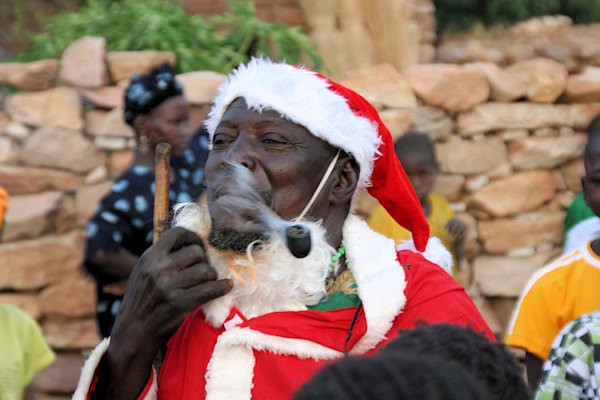 |
|||||
Suprisingly, it emerged that these isolated animist were familiar with several cosmic objects
invisible to the naked eye, for instance Saturn's rings and four of jupiter's
moons.
More intriguing still were the traditions and beliefs relating to Sirius, the brightest star
as seen from earth, and the most venerated celestial object in Dogon culture. Sirius the priest
explained, is not one star but three, with the bright main star orbited by two other stars that
are invisible from earth - the bright white Pa Tolo (Seed star) and duller Emme Ya
(Sorghum female). The odd thing about this was that the existence of Pa Tolo - or
Sirius B - had gone unsuspected by Europeans prior to the early 20th century.
So how was it that this remote African tribe had know about the exstence of Siruis B centuries
earlier ??
It was Robert Temple, who postulated in his controversial book The Sirius Mystery
that the only credible explanation for the Dogon's knowledge of Sirius B is that the amphibious
deity they know as Nommo was in fact a group of spaceman from Sirius who visited earth and
passed on information about their home solar system to the Dogon.
See my
things to read-pages for more information about this book.
Knowing all this, i was confused, meeting Santa Claus on Christmas Eve in the
Dogon Country.
It at most shows the Dogon people's tolerence for other beliefs.